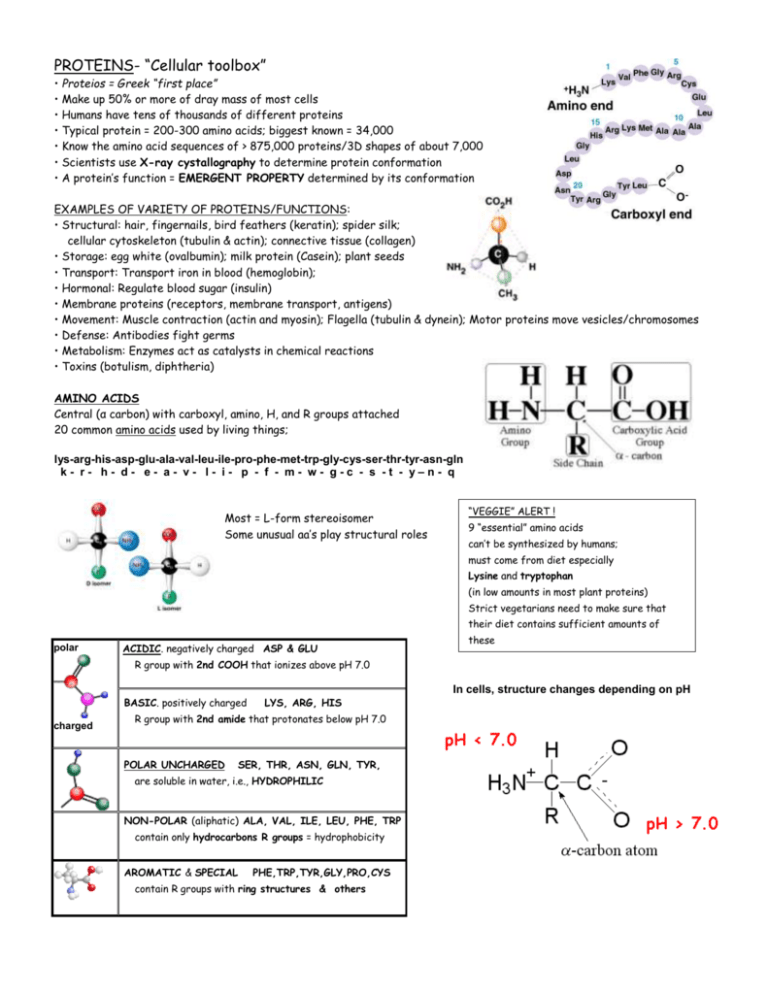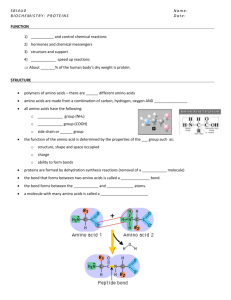proteins aminacids notesKelly
advertisement

PROTEINS- “Cellular toolbox” • Proteios = Greek “first place” • Make up 50% or more of dray mass of most cells • Humans have tens of thousands of different proteins • Typical protein = 200-300 amino acids; biggest known = 34,000 • Know the amino acid sequences of > 875,000 proteins/3D shapes of about 7,000 • Scientists use X-ray cystallography to determine protein conformation • A protein’s function = EMERGENT PROPERTY determined by its conformation EXAMPLES OF VARIETY OF PROTEINS/FUNCTIONS: • Structural: hair, fingernails, bird feathers (keratin); spider silk; cellular cytoskeleton (tubulin & actin); connective tissue (collagen) • Storage: egg white (ovalbumin); milk protein (Casein); plant seeds • Transport: Transport iron in blood (hemoglobin); • Hormonal: Regulate blood sugar (insulin) • Membrane proteins (receptors, membrane transport, antigens) • Movement: Muscle contraction (actin and myosin); Flagella (tubulin & dynein); Motor proteins move vesicles/chromosomes • Defense: Antibodies fight germs • Metabolism: Enzymes act as catalysts in chemical reactions • Toxins (botulism, diphtheria) AMINO ACIDS Central (α carbon) with carboxyl, amino, H, and R groups attached 20 common amino acids used by living things; lys-arg-his-asp-glu-ala-val-leu-ile-pro-phe-met-trp-gly-cys-ser-thr-tyr-asn-gln k- r- h- d- e- a- v- l- i- p - f - m- w- g-c - s -t - y–n- q Most = L-form stereoisomer Some unusual aa’s play structural roles “VEGGIE” ALERT ! 9 “essential” amino acids can’t be synthesized by humans; must come from diet especially Lysine and tryptophan (in low amounts in most plant proteins) Strict vegetarians need to make sure that their diet contains sufficient amounts of polar ACIDIC. negatively charged ASP & GLU these R group with 2nd COOH that ionizes above pH 7.0 In cells, structure changes depending on pH BASIC. positively charged charged LYS, ARG, HIS R group with 2nd amide that protonates below pH 7.0 POLAR UNCHARGED SER, THR, ASN, GLN, TYR, are soluble in water, i.e., HYDROPHILIC NON-POLAR (aliphatic) ALA, VAL, ILE, LEU, PHE, TRP contain only hydrocarbons R groups = hydrophobicity AROMATIC & SPECIAL PHE,TRP,TYR,GLY,PRO,CYS contain R groups with ring structures & others POLYPEPTIDE = polymer of amino acid subunits connected in a specific sequence An enzyme joins the carboxyl of one amino acid and the amino group of another via dehydration synthesis/condensation reaction to form a PEPTIDE BOND Peptide bonds are rigid, planar structures The -NH bond and the -C=O bond, point away from each other so these groups can hydrogen bond to other parts of chain LEVELS OF PROTEIN ORGANIZATION/3-STRUCTURE Primary Structure: unique sequence of amino acids; determined by DNA code; unique for each protein Secondary Structure: Determined by amino acid sequence; HYDROGEN BONDS (between the oxygen of C=O and the hydrogen of N-H of peptide bonds) stabilize structure & form pattern • α helix- polypeptide chain winds clockwise like a spiral staircase EX: KERATIN, the main protein component of hair, nails, horns • β pleated sheet- chains joined together like the logs in a raft EX: SILK Tertiary Structure: Hydrogen bonding, ionic interactions, hydrophobic interactions, and disulfide bridges between R groups stabilize 3 D shape IONIC INTERACTIONS between +/ – charged amino acids - -=glutamate, aspartate + = lysine, arginine, histidine HYDROGEN BONDING Some R groups able to form Hydrogen bonds Helps stabilize 3D structure Quaternary Structure: protein made up of more than one amino acid chain EX: COLLAGEN 3 polypeptide chains twisted in super coil hy dr op hy lli c io nic hy dr op hob ic + S S S DISULFIDE BRIDGES =COVALENT BOND between amino acids w/-SH groups (CYSTEINE but not methionine) forms an -S-S- bridge SIDE NOTE: Perms work by breaking and reforming disulfide bridges in a new hair shape HYDROPHOBIC INTERACTIONS Polar R groups-interact with water and lie on the surface of the protein Nonpolar R groups - hide in the core of the folded protein “ polar outside; nonpolar in.side” EX:HEMOGLOBIN 4 polypeptide chains hy dr og en di su lfid e WHAT DO YOU CALL IT? • two or more amino acids bonded together = PEPTIDE • chain of many amino acids = POLYPEPTIDE • complete folded 3D structure = PROTEIN Final overall protein shapes - FIBROUS. - long fiber shape EX: actin or collagen - GLOBULAR - overall spherical structure EX: hemoglobin, MUTATIONS CAN CHANGE PROTEIN SHAPE Since shape is determined by amino acid sequence; changing sequence changes 3D shape EX: Sickle cell anemia mutation changes one amino acid in the sequence (glu → ala) Abnormal hemoglobin molecules crystallize; cause blood cells to become sickle shaped FACTORS AFFECTING CONFORMATION Folding occurs as protein is synthesized, but physical/chemical environment plays a role DENATURATION: = unraveling/ loss of native confirmation • makes proteins biologically inactive ~ Reason high fevers can be fatal • does NOT break peptide bonds • so primary structure remains intact • may regain its normal structure if conditions change • sometimes = irreversible (ie. cooking an egg) CAUSED BY • changes in pH (alters electrostatic interactions between charged amino acids) • changes in salt concentration (does the same) • changes in temperature (higher temperatures reduce the strength of hydrogen bonds) • presence of reducing agents (break S-S bonds between cysteines) CHAPERONINS = Proteins that stabilize newly-formed polypeptides while they fold into their proper structure • Proteins with hollow cylinder shape • Newly-synthesized protein fits inside while it folds • inner wall of the cylinder is lined with hydrophobic amino acids • keeps hydrophobic regions of the polypeptide away from cytosol/other proteins while it folds • use ATP as the energy source to do this work • May also help refold proteins denatured by heat (HEAT SHOCK PROTEINS) PROTEIN AGGREGATION (=clumping) Cause of some disorders EX: Alzheimer's disease, Huntington's disease, and prion diseases (e.g., "mad-cow" disease) ??? possible a failure of chaperones is involved??? If so, perhaps treatment possible by increasing the efficiency of chaperones ????? Other Kinds of Proteins- Simple proteins contain only amino acids Conjugated proteins contain other kinds of molecules Ex: glycoproteins contain carbohydrates, nucleoproteins contain nucleic acids, lipoproteins contain lipids http://local.brookings.k12.sd.us/krscience/open/chemistryoflife.htm AMINO ACIDS- You DON’T have to memorize them all, but you should know a few, the basic structure of an amino acid, and be able to answer questions about what kind of functional groups make the different kinds (Polar, Nonpolar, Charged) Image from AP BIOLOGY by Neil Campbell and Jane Reece; 7th ed








